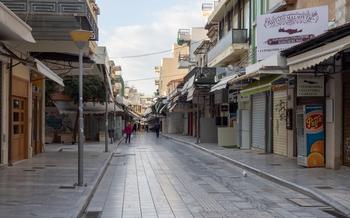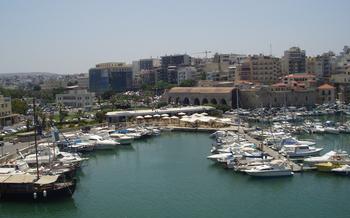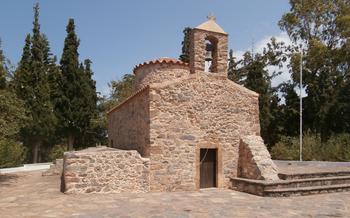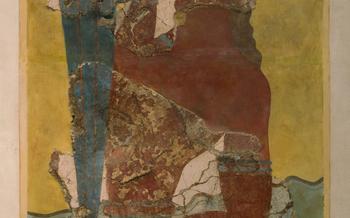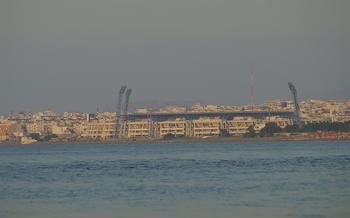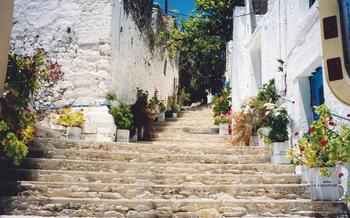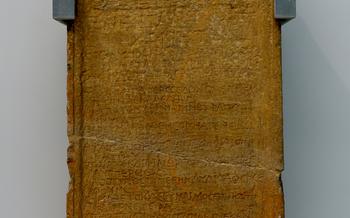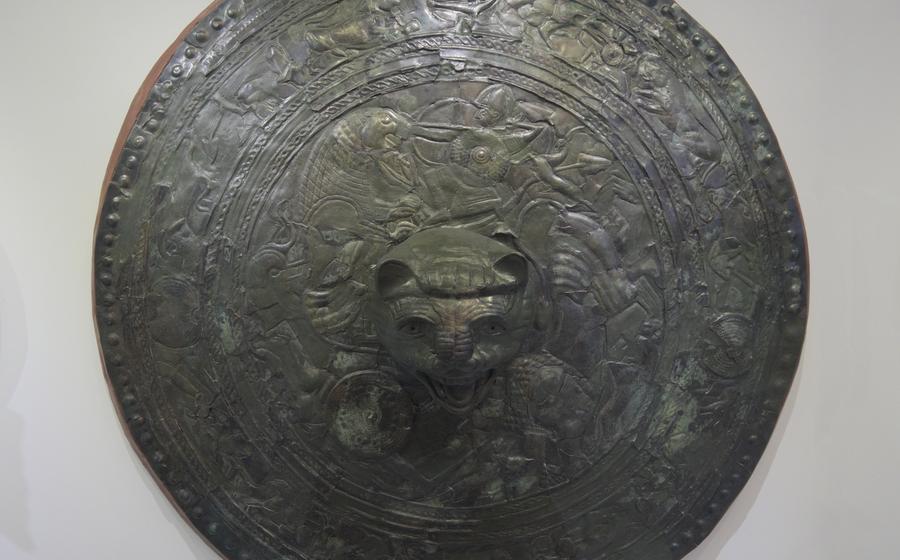
Cave of Zeus
- Location and Accessibility:
- A Natural Wonder
- Historical Importance
- Guided Tours
- What to Bring:
- Best Time to Visit:
- Duration of the Visit
- Entrance Fees and Tickets:
- Photography and Videography
- Safety and Precautions
- Exploring the Surroundings
- Cultural Significance
- Mythological Creatures
- Insider Tip: Unveiling the Cave's Secrets
Location and Accessibility:
The Cave of Zeus is nestled in the heart of Mount Dikti, a majestic mountain range that dominates the eastern part of Crete. The cave is situated near the village of Psychro, approximately 35 kilometers southeast of Heraklion, the capital of Crete. Reaching the cave requires a scenic drive through the picturesque countryside, offering breathtaking views of the Cretan landscape.
To get to the cave, you can opt for a self-guided tour or join an organized excursion. If driving independently, follow the signs from Heraklion towards Psychro. Once in Psychro, follow the road leading to the cave, which is well-marked and accessible by car.
For those who prefer a guided experience, numerous tour operators in Heraklion offer day trips to the Cave of Zeus. These tours typically include transportation, a guided tour of the cave, and sometimes additional activities, such as a visit to the nearby Lassithi Plateau or the Minoan Palace of Malia.
A Natural Wonder
The Cave of Zeus is a geological marvel that showcases the wonders of nature's artistry. As visitors step inside, they are greeted by a symphony of stalactites and stalagmites, each one a testament to the patient work of water seeping through the limestone rock over millennia. The stalactites, hanging like chandeliers from the ceiling, and the stalagmites, rising from the ground like ancient pillars, create an ethereal and awe-inspiring atmosphere.
The cave's walls are adorned with intricate patterns and textures, formed by the relentless dripping of water. The play of light and shadow on these formations creates a kaleidoscope of colors and shapes, transforming the cave into a subterranean wonderland. Visitors can't help but marvel at the sheer beauty and majesty of this natural wonder, a true testament to the power of time and nature.
Beyond the stalactites and stalagmites, the Cave of Zeus offers other geological surprises. There are hidden chambers and passageways, each with its own unique features. Some chambers are adorned with sparkling crystals, while others reveal ancient fossils, providing a glimpse into the geological history of the region. The cave's intricate network of tunnels and chambers makes it a fascinating place to explore, offering a sense of adventure and discovery.
Historical Importance
The Cave of Zeus is not merely a natural wonder; it also holds immense historical significance. Archaeological excavations have uncovered evidence of ancient rituals and ceremonies performed within its depths. These discoveries suggest that the cave was a sacred site for the Minoans, an ancient civilization that flourished on Crete during the Bronze Age. Archaeologists have found pottery, tools, and other artifacts that provide clues to the religious practices and beliefs of the Minoans.
Furthermore, the cave's location near the ancient city of Knossos, the center of Minoan civilization, further underscores its importance. It is believed that the cave may have been used for religious ceremonies related to the worship of Zeus, the king of the gods in Greek mythology. The cave's association with Zeus has led to its enduring significance as a historical and cultural landmark.
In addition to its religious significance, the Cave of Zeus also played a role in the history of Crete as a refuge and hiding place during times of conflict. During the Venetian occupation of Crete, the cave served as a shelter for rebels and freedom fighters who sought refuge from their oppressors. The cave's hidden location and difficult accessibility made it an ideal sanctuary for those seeking to evade capture.
Exploring the Cave of Zeus offers a glimpse into the rich history and culture of Crete. Visitors can walk in the footsteps of ancient Minoans, imagine the rituals and ceremonies that took place within the cave, and appreciate its enduring significance as a historical and cultural landmark.
Guided Tours
To fully appreciate the historical and mythological significance of the Cave of Zeus, consider booking a guided tour. Knowledgeable guides can provide insights into the cave's geology, history, and cultural importance, enhancing your overall experience. Guided tours typically last for around 30 to 45 minutes and offer a wealth of information about the cave's formations, archaeological discoveries, and legends associated with Zeus.
Guides are experts in the cave's history and can share fascinating stories and anecdotes that bring the cave to life. They can point out specific features, explain their significance, and answer any questions you may have. With a guide, you'll gain a deeper understanding of the cave's role in Greek mythology and its connection to the birth of Zeus, making your visit even more memorable.
To book a guided tour, you can either purchase tickets directly at the cave's entrance or book in advance through tour operators or online platforms. Advance booking is recommended during peak tourist season to avoid disappointment and secure your spot. Guided tours are available in multiple languages, so you can choose the one that suits you best.
What to Bring:
When embarking on your journey to the Cave of Zeus, it's essential to be well-prepared to ensure a comfortable and enjoyable visit. Here's a list of essential items to pack for the adventure:
Comfortable Shoes: - Prioritize wearing sturdy and comfortable footwear with good traction, as the cave terrain can be uneven and slippery. Avoid sandals or flip-flops, as they may not provide adequate support or protection.
Water and Snacks: - Pack an ample supply of water to stay hydrated during your exploration. You might also want to bring along some light snacks to replenish your energy, such as granola bars or fruit.
Flashlight or Headlamp: - While the cave is generally well-lit, having a personal light source can be beneficial for exploring darker corners or taking photographs with better lighting.
Camera and Accessories: - If you're passionate about photography, bring your camera and essential accessories. The cave offers stunning photo opportunities, especially with the unique rock formations and natural lighting.
Warm Clothing: - The cave's temperature can be chilly, so consider bringing a light jacket or sweater, particularly if visiting during cooler months.
Dress Appropriately: - Avoid wearing loose or flowing clothing, as they might get caught on cave formations or restrict your movement. Opt for comfortable, form-fitting attire that allows for easy exploration.
Best Time to Visit:
The timing of your visit to the Cave of Zeus can significantly enhance your experience. To avoid the summer crowds and the scorching heat, consider exploring the cave during the shoulder seasons of spring (April-May) or autumn (September-October). During these periods, you'll have a more tranquil and enjoyable journey through the cave.
As for the time of day, aim to arrive early in the morning or late in the afternoon. This strategy will enable you to beat the midday heat and relish a more intimate encounter with the cave's wonders. Plus, you'll have the chance to capture stunning photographs bathed in the golden light of the rising or setting sun.
Weather conditions can be unpredictable, especially in the winter months. Check the forecast before your visit to ensure the cave is open and accessible.
Duration of the Visit
The duration of your visit to the Cave of Zeus can vary depending on several factors, including your pace, level of interest, and whether or not you choose to take a guided tour. On average, visitors spend around 30 to 45 minutes exploring the cave. However, if you're particularly fascinated by the geological formations, the history, or the mythology associated with the site, you may want to allocate more time for your visit.
Guided tours typically last for about an hour, as they provide additional insights and information about the cave's features and history. If you opt for a guided tour, make sure to arrive a few minutes early to ensure you don't miss the start.
To make the most of your visit, plan to arrive with ample time to explore the surrounding area as well. The Cave of Zeus is nestled amidst a beautiful natural landscape, and there are several nearby attractions and points of interest that you might want to incorporate into your itinerary.
Remember that the cave can be slippery in some areas, so it's essential to wear comfortable, sturdy shoes. Also, be mindful of your surroundings and avoid touching the delicate stalactites and stalagmites. With a bit of planning and preparation, you can ensure a comfortable and thorough exploration of the Cave of Zeus.
Entrance Fees and Tickets:
Visiting the Cave of Zeus is an affordable experience that allows travelers to delve into the depths of Greek mythology and natural wonders. The entrance fee is set at a reasonable rate, making it accessible to visitors of all budgets. To purchase tickets, you can either visit the ticket office located at the entrance of the cave or book your tickets online in advance. Booking online is recommended during peak tourist season to avoid queues and ensure a smooth and convenient visit. Discounts are available for students, seniors, and families, so be sure to inquire about these options when purchasing your tickets.
Photography and Videography
The Cave of Zeus offers a unique opportunity to capture stunning photographs and videos that will immortalize your visit. The natural formations, intricate patterns, and beautiful colors of the cave create a breathtaking backdrop for any visual medium.
To make the most of your photographic and videographic experience, consider the following tips:
-
Lighting: The cave's natural lighting is often dim and variable, so it's essential to adjust your camera settings accordingly. Bringing a tripod can help stabilize your camera and reduce blur in low-light conditions.
-
Composition: Take your time to compose your shots carefully. The cave's formations offer a variety of interesting angles and perspectives. Experiment with different compositions to create visually appealing images.
-
Flash Photography: Be mindful of using flash photography, as it can create harsh shadows and distort the natural colors of the cave's formations. If you must use flash, bounce it off the cave walls to create a softer, more natural light.
-
Respect the Environment: Remember that the cave is a fragile ecosystem, and it's important to minimize your impact on the environment. Avoid touching the formations or leaving any trash behind.
By following these tips, you can capture stunning photos and videos that will allow you to share the beauty and wonder of the Cave of Zeus with others.
Safety and Precautions
The Cave of Zeus is generally a safe place to visit, but certain precautions should be taken to ensure a smooth and enjoyable experience. The cave floor can be slippery, so it's advisable to wear sturdy, non-slip shoes. Uneven surfaces and low-hanging stalactites are present, so it's essential to watch your step and maintain awareness of your surroundings. Visitors with limited mobility or claustrophobia should carefully consider their ability to navigate the cave's narrow passages and confined spaces.
For those with respiratory conditions, it's worth noting that the cave's atmosphere can be humid and dusty. If you have concerns, consider bringing a face mask or inhaler if necessary. Additionally, it's important to stay hydrated, especially during warmer months or if you're prone to dehydration. Remember to bring a water bottle or refill it at the nearby facilities.
To protect the cave's delicate ecosystem and preserve its natural beauty, visitors are kindly requested to refrain from touching or damaging the rock formations. Flash photography is also discouraged, as it can disturb the cave's inhabitants and potentially harm the sensitive rock formations. By following these precautions, you can help ensure the safety and preservation of the Cave of Zeus for future generations to enjoy.
Exploring the Surroundings
The Cave of Zeus is not just an isolated attraction; it's nestled within a region rich in history and natural beauty. Take advantage of your visit to explore the surrounding area and discover other hidden gems.
-
Knossos Palace: A short drive from the cave, you'll find the ruins of the ancient Minoan palace of Knossos. Explore the grand halls, intricate frescoes, and fascinating history of this Bronze Age civilization.
-
Heraklion Archaeological Museum: The museum houses a vast collection of artifacts from Minoan, Greek, and Roman periods. It's a treasure trove for history buffs and provides valuable context for the Cave of Zeus.
-
Diktean Cave: Just a few kilometers away, you can visit another significant cave, the Diktean Cave. According to mythology, this cave was where Zeus was raised by the goat Amalthea.
-
Lassithi Plateau: Immerse yourself in the serene beauty of the Lassithi Plateau, a fertile valley surrounded by mountains. Enjoy panoramic views, traditional villages, and local delicacies.
-
Malia Palace: Explore the ruins of another Minoan palace, Malia. While smaller than Knossos, it offers a glimpse into the Minoan civilization's architectural and artistic achievements.
For an unforgettable experience, combine your visit to the Cave of Zeus with a tour of these nearby attractions. Discover the rich cultural tapestry of Crete and create lasting memories.
Cultural Significance
The Cave of Zeus holds immense cultural significance, deeply rooted in Cretan culture and traditions. It is not merely a natural wonder but a place that has played a pivotal role in local mythology and beliefs. The cave is considered a sacred site, where ancient rituals and ceremonies were once performed, connecting the present with the past. Visiting the Cave of Zeus offers a glimpse into the rich cultural heritage of Crete, allowing visitors to explore the profound connection between nature and spirituality that has shaped the island's history and identity. Preserving and celebrating this cultural heritage is essential for understanding the essence of Crete and fostering a sense of pride and belonging among its people.
Mythological Creatures
The Cave of Zeus is steeped in the realm of Greek mythology, where legends of mythical creatures and divine beings intertwine. According to ancient tales, the cave was not only the birthplace of Zeus but also the dwelling place of various mythological figures.
One of the most prominent creatures associated with the cave is the Minotaur, a mythical beast with the body of a man and the head of a bull. Legends depict the Minotaur as a ferocious creature that resided in the labyrinthine depths of the cave, devouring young maidens and Athenian youths as sacrifices.
Another mythical creature linked to the cave is the Talos, a bronze giant crafted by Hephaestus, the god of fire and metalworking. Talos was tasked with protecting the island of Crete from invaders, patrolling the coastline and hurling boulders at approaching ships.
These legends add a layer of enchantment to the Cave of Zeus, inviting visitors to explore the realm of Greek mythology and immerse themselves in the stories of ancient gods, heroes, and mythical creatures.
Insider Tip: Unveiling the Cave's Secrets
As you venture deeper into the Cave of Zeus, keep an eye out for a hidden chamber tucked away from the main path. This secret spot, often overlooked by visitors, offers a breathtaking view of a crystal-clear underground lake. The water shimmers with an ethereal glow, reflecting the intricate patterns of the cave ceiling.
For a truly unforgettable experience, plan your visit during the summer months when the sunlight streams through a small opening in the cave, illuminating the lake with a magical golden light. It's a moment of pure enchantment, as if nature itself is revealing a hidden treasure.
Another secret worth discovering is the "Echoing Gallery." As you whisper or clap your hands, the acoustics of the cave create a mesmerizing echo that reverberates through the chamber. It's a playful way to interact with the cave and experience its unique sonic properties.
Capture the beauty of these hidden gems with your camera, but remember to respect the sanctity of the site and minimize any disturbance to the natural environment. Let the Cave of Zeus unveil its secrets, leaving you with memories that will last a lifetime.
